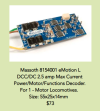Hello, I have an older LGB 23252 Columbus Forney with sound which accepts an optional LGB 55021 Decoder that plugs directly on top of the board. I added the decoder 15 years ago and have not run the older DCC it in over 14 years. I have recently started using an MTSIII with Massoth navigator and have been running much newer equipment which operates in parallel. What do I need to do to make this older Locomotive functions work in Parallel as I can't stand the old Serial method? Is it a matter of a decoder change, a CV change or scrap the entire electronics for a New Sound Decoder? I like the sound system and hate to remove it but the serial thing is not for me. Thanks, Richard
Last edited:

